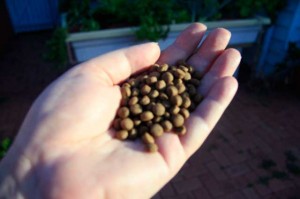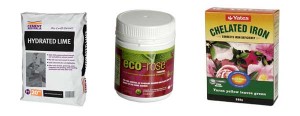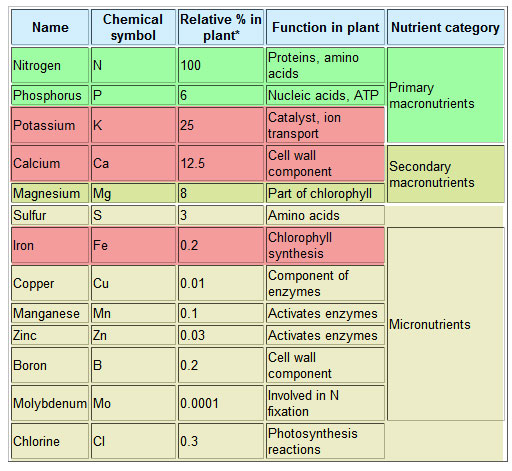Are you supplying enough Nutrients?
 Getting lush green growth from your Aquaponics system should be easy. In most home systems it is, but how do you know that your plants are getting all the nutrients they need from the things you add into your aquaponics system?
Getting lush green growth from your Aquaponics system should be easy. In most home systems it is, but how do you know that your plants are getting all the nutrients they need from the things you add into your aquaponics system?
The plants may look okay but how can you tell for sure that they are getting everything they need?
Some people will tell you that they don’t add anything other than fish pellets into a system. But are fish pellets enough to grow healthy fish and thriving plants?
Well according to Dr Jim Rakocy a leading scientific expert in Aquaponics, if you only add fish pellets as a fuel to power your system then you are not supplying your plants with the thirteen nutrients elements that are needed for healthy plant growth.
Thats right. There are thirteen essential nutritional elements plants need for growth.
Fish Pellets according to Dr Jim Rakocy can only supply 10 essential nutrient elements.
You’ll need to add the others if you want your plants to thrive. They are:
- Calcium
- Potassium
- Iron
“Calcium, Potassium and Iron are generally too low in an aquaponics system for good plant growth ” says Dr Rakocy, ” and must be supplemented.”
Rakocy goes on to say, “In the UVI system, calcium and potassium are supplemented by adding basic compounds (Calcium hydroxide and potassium hydroxide) to adjust pH. Iron is added as a chelated compound.”
And its your job to make sure you can add the three elements to your system. Failure to do so can result in problems later on with your plant growth.
If you notice, Chlorosis or yellowing of plant tissue, lack of new growth and a stunted appearance, then you may need to add a few extra additives.
The good part is that some of these nutrients are inexpensive and easy to find and will last for years. Lets take a look at where to get them.
-
- Calcium can be found in any building supply store. Its found with the bags of cement. Builders Lime, also known as slaked lime (Calcium Hydroxide) is cheap to buy and will last for years when used occasionally with your aquaponics system. Its also used to buffer the system as it ages and gets more acidic.
- Chelated Iron or iron that is soluble in water can also be purchased in Australia as Yates Chelated Iron. Its a yellow granular powder that can be applied directly to your fish tank or grow bed and will not harm the fish.
- Potassium Hydroxide is also known as caustic potash. Sourcing it may prove to be difficult. Try Soap making supply places. We have substituted it with Potassium Bicarbonate, under the name Eco-Rose found in specialty garden centres in Australia with good results. It also comes in a granular form and only requires a teaspoon or two to supply your system with the missing nutrients.
More information on adding nutrients can be found in Murray Hallam’s Aquaponics Secrets DVD as well as his DIY Aquaponics DVD which features Murray explaining the use of adding additives in more detail. Murray is also fond of adding Rock Dust which contains many trace elements beyond the 13 known plant nutrients. Rock Dust is something many people are unaware or deem unnecessary in Aquaponics. Its benefits are not immediately obvious but to the myriad of living bacteria and biota at work in your growbed adding a smorgasbord of other nutrient elements that assist in the vitality of your living eco-system is just a bonus.
The Nutrient Chart
The primary or Macronutrients shown in the chart above (nitrogen, phosphorus, potassium, calcium, magnesium and sulfur) are plant nutrients that are required in the large concentrations in plants.
The secondary macronutrients and the micronutrients are needed in less concentrations but are still essential to optimum plant growth. Some of these elements can be supplied through a regular dose of seaweed concentrate or Seasol/Maxicrop.
When adding additives to your system, take a note of the absorption take up rate that plants require as shown on the chart and balance your dosage accordingly.
A small slurp into your system is all that it takes for the plants to get their required dosage. An additional tonic of worm juice added every now and then is a great tonic to boost the system with trace elements processed by compost worms. Read more about whats in worm juice and how to make your own worm farm here. A natural and healthy way to boost your aquaponics system and keep your plants looking healthy.
If your aquaponics system looks a little lacklustre – perhaps some of these tips can reinvigorate the system. We use this stuff in ours and our plant growth is spectacular. Best of all, you can purchase these things inexpensively. Happy Aquaponics.










Just ordered some potassium hydroxide. My girlfriend makes soap so we’ll get double use out of it. Only thing I’m concerned about is that I’ve got naturally high pH due to our water supply and just local environment. Everything around here is limestone or has limestone in it. How much should I use at a time and is it going to drive my pH waaay up?
Never use limestone gravel in your growbeds as you will always have high pH issues. Use neutral pH 3/4 inch gravel of around pH 7. With an average sized system of around 1,000 liters, first bring your pH down using a cap or a tablespoon of hydrochloric acid and get that stabilized first (say pH 6.4 – 6.8) and then use a teaspoon a day of potassium hydroxide added to your water and re test daily. It will buffer your system up slightly to around pH 7. Test your pH daily and readjust as necessary. Sudden violent swings of pH will kill your fish. Small adjustments are the key to success. Over time bacteria will acidify your system and bring the pH down. Adding a little potassium hydroxide every few weeks will balance the system and keep your plants well fed and looking good.
Great article Frank. I especially loved the chart. What do you and Dr. Lennard think of using Maxicrop with Iron? Chelated Iron can be a bit tough to find around here and this might “kill two birds with one stone”.
Hi Sylvia, just checking whats in Maxicrop Plus Iron…
I’d give my system a small splash. See what happens…The Chlorine in the Maxicrop must be there to stop the brew from fermenting…
Oh I didn’t intentionally add limestone to the system. When I first set it up years ago I looked for gravel without limestone. I even ended up buying some gravel and was told it didn’t contain limestone. Well no dice. If you’re in central Texas then any gravel you can get at bulk prices has limestone in it. At least that’s my experience. I’ve since switched to lava rock. But even without the limestone gravel our tap water comes out 8.5 – 9.0 because it comes from a river filled with limestone. In the summer when it’s 100+ degrees we get quit a bit of evaporation and have to resort to topping off with tap water. I usually add some vinegar to the tap water but I’ll be damned if the system’s pH never goes below 7.6.